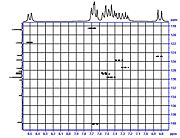2D HSQC
From NMR Wiki
(Difference between revisions)
| Line 1: | Line 1: | ||
[[Image:Sudan I HSQC.jpg|thumb|{{1H}},{{13C}}-HSQC of Sudan I dye]] | [[Image:Sudan I HSQC.jpg|thumb|{{1H}},{{13C}}-HSQC of Sudan I dye]] | ||
| - | 2D [[HSQC]] (Heteronuclear Single Quantum Coherence) experiment correlates chemical shifts of directly bound nuclei (i.e. two types of chemical nuclei). For example {{1H}},{{15N}}-HSQC correlates chemical shifts within NH groups. | + | 2D [[HSQC]] (Heteronuclear Single Quantum Coherence) experiment correlates chemical shifts of directly bound nuclei (i.e. two types of chemical nuclei). For example {{1H}},{{15N}}-HSQC correlates chemical shifts within NH groups. For similar correlations over multiple bonds [[HMBC]] experiment can be used. |
{{1H}},{{15N}}-HSQC and {{1H}},{{13C}}-HSQC are frequently used for liquid-state protein NMR spectroscopy. | {{1H}},{{15N}}-HSQC and {{1H}},{{13C}}-HSQC are frequently used for liquid-state protein NMR spectroscopy. | ||
Revision as of 13:33, 9 June 2010
2D HSQC (Heteronuclear Single Quantum Coherence) experiment correlates chemical shifts of directly bound nuclei (i.e. two types of chemical nuclei). For example 1H,15N-HSQC correlates chemical shifts within NH groups. For similar correlations over multiple bonds HMBC experiment can be used.
1H,15N-HSQC and 1H,13C-HSQC are frequently used for liquid-state protein NMR spectroscopy.
Chemical shift of one nucleus - usually 1H is detected in the directly measured dimension, while chemical shift of second nucleus (heteronucleus or X-nucleus) is recorded in the indirect dimension.
Recently modified HMQC experiment allowed to measure correlation faster using Ernst-angle pulse instead of 90° pulse ( SOFAST HMQC )
Implementations
- 13C HSQC decoupler2 (Rutgers Univ.)
- 13C-HSQC, 15N decoupling, SE, 500 MHz Inova (G. Montelione, Rutgers Univ.)
- 13C-HSQC, 600 MHz Inova (Rutgers Univ.)
- 15N-HSQC with T2 measurement (Rutgers Univ.)
- 15N-HSQC with T2 measurement, PFG version (Rutgers Univ.)
- 15N-HSQC, 600 MHz Inova (Rutgers Univ.)
- 15N-HSQC, with 13C decoupling and SE 500 MHz Inova (G. Montelione, Rutgers Univ.)
- BIP 13C-HSQC (xm gsHSQC Carbon.c)
- Ser/Thr-(HC)NH HSQC (J. Chugh and R.V. Hosur, TIFR)
- TROSY 500 MHz Inova (G.Montelione, Rutgers Univ.)
- TROSY 600 MHz Inova (Rutgers Univ.)


